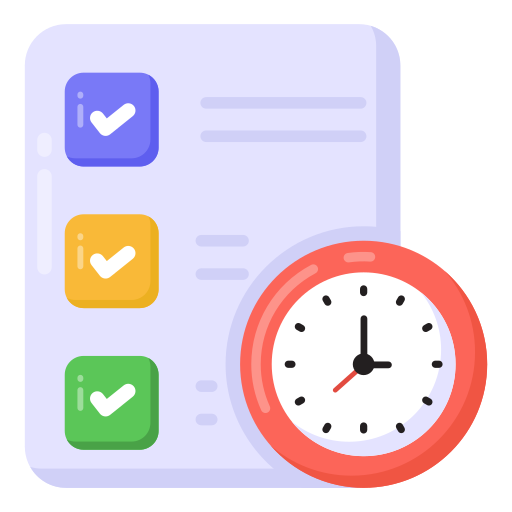Introducing AI for customer service
Powerful AI that takes care of your daily tasks. Stop manually processing your text, document, and image data. Let AI work its magic, without a single line of code.
Top Stories
Date and Time Converters
Time on your side: Convert and conquer your schedule effortlessly!
Date and Time Converters
Time on your side: Convert and conquer your schedule effortlessly!
Mastering Time: The Ultimate Guide to Time Conversion
In the hustle and bustle of modern life, time is both a precious commodity and a constant challenge to manage effectively. From seconds to years, understanding and converting time units are essential skills for optimizing productivity, planning events, and coordinating schedules. With the help of advanced tools like the versatile time converter, mastering time conversion has never been easier. In this comprehensive guide, we’ll explore the significance of time conversion, the importance of efficient time management, and how to utilize a time converter effectively.
Why Time Conversion Matters
Time conversion plays a crucial role in various aspects of life, from everyday tasks to complex project management. Whether you’re planning a trip, scheduling meetings, or coordinating international events, the ability to convert between different time units is invaluable. It allows you to communicate effectively across time zones, synchronize activities, and ensure smooth transitions between various time frames.
The Significance of Efficient Time Management
Effective time management is the cornerstone of productivity and success in both personal and professional endeavors. By optimizing how we allocate and utilize our time, we can accomplish more tasks, reduce stress, and achieve our goals more efficiently. Time conversion facilitates better time management by enabling us to break down large time frames into smaller, more manageable segments, allowing for better planning and organization.
Introducing the Date and Time Converter
The time converter is a powerful tool that simplifies the process of converting between different time units. Whether you need to convert seconds to minutes, hours to days, or years to weeks, the time converter provides accurate and efficient solutions. With user-friendly interfaces and intuitive features, these converters make time conversion accessible to everyone, regardless of their mathematical proficiency.
Key Features of a Time Converter
- Versatility: A comprehensive time converter should support conversion between a wide range of time units, including seconds, minutes, hours, days, weeks, months, and years.
- Accuracy: Accuracy is paramount when it comes to time conversion. A reliable time converter should provide precise results to ensure consistency and reliability.
- User-Friendly Interface: The interface of the time converter should be intuitive and easy to navigate, allowing users to input their desired values and obtain results quickly.
- Customization Options: Advanced time converters may offer customization options, such as specifying time zones or adjusting for daylight saving time, to meet specific user needs.
How to Use a Time Converter Effectively
Using a time converter is straightforward and requires only a few simple steps:
-
- Select the starting time unit (e.g., seconds, minutes, hours, etc.).
- Enter the value you wish to convert.
- Choose the desired output time unit.
- Click the “Convert” button to obtain the converted value.
Benefits of Using a Time Converter
- Time Savings: By automating the time conversion process, a time converter saves users valuable time and effort.
- Accuracy: With precise calculations, a time converter eliminates the risk of human error, ensuring reliable results every time.
- Convenience: Accessible online or through mobile applications, time converters are available whenever and wherever users need them.
- Flexibility: Users can convert between different time units on the fly, allowing for quick adjustments and adaptations to changing circumstances.
1. Time Converter: Your Ultimate Tool for Time Management
In a world where time is of the essence, having the right tools at your disposal can make all the difference. Enter the time converter – your go-to solution for efficiently managing and manipulating time units. Whether you’re planning a project, scheduling appointments, or simply organizing your day, a reliable time converter is an indispensable asset. In this article, we’ll delve into the various features and benefits of a time converter and explore how it can streamline your time management efforts.
Key Features of a Time Converter:
- Versatility: From seconds to years and everything in between, a time converter should support conversion between a wide range of time units to accommodate diverse needs.
- Accuracy: Precision is paramount when it comes to time management. A dependable time converter ensures accurate conversions, allowing you to make informed decisions and stay on track.
- User-Friendly Interface: The interface of a time converter should be intuitive and easy to navigate, enabling users to input values and obtain results with minimal effort.
- Customization Options: Advanced time converters may offer customization features, such as specifying time zones or adjusting for daylight saving time, to cater to individual preferences.
Benefits of Using a Time Converter:
- Efficiency: By automating the time conversion process, a time converter saves users time and effort, allowing them to focus on more important tasks.
- Accuracy: With precise calculations, a time converter eliminates the risk of errors, ensuring reliable results every time.
- Convenience: Accessible online or through mobile applications, time converters are available whenever and wherever users need them, offering unparalleled convenience.
- Flexibility: Users can convert between different time units on the fly, enabling quick adjustments and adaptations to changing circumstances.
In summary, a time converter is a valuable tool for enhancing time management and productivity. Whether you’re a busy professional, a diligent student, or an ambitious entrepreneur, incorporating a time converter into your toolkit can help you make the most of your time and achieve your goals with ease.
2. Convert Seconds to Minutes: Making Every Second Count
In the realm of time management, every second matters. Whether you’re timing an activity, calculating durations, or simply keeping track of time, the ability to convert seconds to minutes is essential. In this article, we’ll explore why converting seconds to minutes is important, how to do it accurately, and how a time converter can simplify the process.
Why Convert Seconds to Minutes?
- Precision: Converting seconds to minutes allows for more precise time measurements, particularly when dealing with smaller time intervals.
- Standardization: Minutes are a common unit of time used in various contexts, making it easier to communicate and compare time durations.
- Efficiency: Converting seconds to minutes can streamline calculations and simplify time management tasks, saving valuable time and effort.
How to Convert Seconds to Minutes:
- Manual Calculation: To convert seconds to minutes manually, divide the number of seconds by 60 (since there are 60 seconds in a minute).
- Using a Time Converter: Alternatively, you can use a time converter to automate the conversion process, entering the number of seconds and obtaining the equivalent value in minutes instantly.
Benefits of Using a Time Converter for Seconds to Minutes Conversion:
- Speed: With just a few clicks, a time converter can provide accurate conversions in a matter of seconds, saving time and effort.
- Accuracy: Time converters ensure precise calculations, eliminating the risk of errors commonly associated with manual calculations.
- Convenience: Accessible online or through mobile applications, time converters offer unparalleled convenience, allowing users to convert seconds to minutes anytime, anywhere.
In conclusion, converting seconds to minutes is a fundamental aspect of time management. Whether you’re timing an event, scheduling tasks, or managing your day-to-day activities, having the ability to convert between different time units is invaluable. With the help of a reliable time converter, you can make every second count and maximize your productivity with ease.
3. Convert Minutes to Hours: Streamlining Time Management
Time is a precious resource, and effective time management is essential for success in both personal and professional endeavors. Whether you’re planning your day, scheduling appointments, or allocating project deadlines, the ability to convert minutes to hours is a valuable skill. In this article, we’ll explore why converting minutes to hours is important, how to do it accurately, and how a time converter can simplify the process.
Why Convert Minutes to Hours?
- Simplicity: Hours are a commonly used unit of time for scheduling and timekeeping, providing a standardized framework for organizing activities.
- Efficiency: Converting minutes to hours allows for more efficient time management, particularly when dealing with larger time intervals.
- Clarity: Hours provide a clearer and more concise representation of time, making it easier to communicate and coordinate schedules with others.
How to Convert Minutes to Hours:
- Manual Calculation: To convert minutes to hours manually, divide the number of minutes by 60 (since there are 60 minutes in an hour).
- Using a Time Converter: Alternatively, you can use a time converter to automate the conversion process, entering the number of minutes and obtaining the equivalent value in hours instantly.
Benefits of Using a Time Converter for Minutes to Hours Conversion:
- Accuracy: Time converters ensure precise calculations, eliminating the risk of errors commonly associated with manual calculations.
- Speed: With just a few clicks, a time converter can provide accurate conversions in a matter of seconds, saving time and effort.
- Convenience: Accessible online or through mobile applications, time converters offer unparalleled convenience, allowing users to convert minutes to hours anytime, anywhere.
In summary, converting minutes to hours is a fundamental aspect of effective time management. Whether you’re planning your schedule, allocating resources, or estimating project timelines, having the ability to convert between different time units is invaluable. With the help of a reliable time converter, you can streamline your time management efforts and make the most of every hour.
4. Convert Hours to Days: Optimizing Time Allocation
In the realm of time management, understanding how to convert hours to days is essential for effective planning and organization. Whether you’re estimating project timelines, scheduling appointments, or budgeting your time, the ability to convert between different time units is invaluable. In this article, we’ll explore why converting hours to days is important, how to do it accurately, and how a time converter can simplify the process.
Why Convert Hours to Days?
- Scale: Converting hours to days allows for a more manageable representation of time, particularly when dealing with longer durations.
- Planning: Days are a common unit of time used for scheduling and project management, providing a standardized framework for organizing activities and deadlines.
- Perspective: Converting hours to days offers a broader perspective on time, making it easier to prioritize tasks and allocate resources effectively.
How to Convert Hours to Days:
- Manual Calculation: To convert hours to days manually, divide the number of hours by 24 (since there are 24 hours in a day).
- Using a Time Converter: Alternatively, you can use a time converter to automate the conversion process, entering the number of hours and obtaining the equivalent value in days instantly.
Benefits of Using a Time Converter for Hours to Days Conversion:
- Accuracy: Time converters ensure precise calculations, eliminating the risk of errors commonly associated with manual calculations.
- Speed: With just a few clicks, a time converter can provide accurate conversions in a matter of seconds, saving time and effort.
- Convenience: Accessible online or through mobile applications, time converters offer unparalleled convenience, allowing users to convert hours to days anytime, anywhere.
In summary, converting hours to days is a fundamental aspect of effective time management. Whether you’re planning long-term projects, scheduling appointments, or setting deadlines, having the ability to convert between different time units is essential. With the help of a reliable time converter, you can optimize your time allocation and make the most of every day.
5. Convert Days to Weeks: Enhancing Time Organization
In the realm of time management, the ability to convert days to weeks is invaluable for effective planning and organization. Whether you’re scheduling events, setting goals, or managing projects, understanding how to convert between different time units is essential. In this article, we’ll explore why converting days to weeks is important, how to do it accurately, and how a time converter can simplify the process.
Why Convert Days to Weeks?
- Structure: Converting days to weeks provides a structured framework for organizing time, particularly when dealing with longer durations.
- Planning: Weeks are a common unit of time used for scheduling and goal-setting, offering a standardized format for setting deadlines and milestones.
- Flexibility: Converting days to weeks allows for greater flexibility in time management, making it easier to adjust schedules and allocate resources as needed.
How to Convert Days to Weeks:
- Manual Calculation: To convert days to weeks manually, divide the number of days by 7 (since there are 7 days in a week).
- Using a Time Converter: Alternatively, you can use a time converter to automate the conversion process, entering the number of days and obtaining the equivalent value in weeks instantly.
Benefits of Using a Time Converter for Days to Weeks Conversion:
- Accuracy: Time converters ensure precise calculations, eliminating the risk of errors commonly associated with manual calculations.
- Speed: With just a few clicks, a time converter can provide accurate conversions in a matter of seconds, saving time and effort.
- Convenience: Accessible online or through mobile applications, time converters offer unparalleled convenience, allowing users to convert days to weeks anytime, anywhere.
In summary, converting days to weeks is a fundamental aspect of effective time management. Whether you’re planning long-term projects, setting goals, or scheduling activities, having the ability to convert between different time units is essential. With the help of a reliable time converter, you can enhance your time organization and achieve your objectives with confidence.
6. Convert Weeks to Months: Streamlining Time Tracking
When it comes to time management, the ability to convert weeks to months is essential for effective planning and organization. Whether you’re setting long-term goals, tracking progress, or budgeting time for projects, understanding how to convert between different time units is invaluable. In this article, we’ll explore why converting weeks to months is important, how to do it accurately, and how a time converter can simplify the process.
Why Convert Weeks to Months?
- Consolidation: Converting weeks to months consolidates time periods into larger, more manageable units, facilitating easier tracking and planning.
- Planning: Months are a common unit of time used for setting goals and deadlines, providing a structured framework for long-term planning and organization.
- Perspective: Converting weeks to months offers a broader perspective on time, making it easier to prioritize tasks and allocate resources effectively.
How to Convert Weeks to Months:
- Manual Calculation: To convert weeks to months manually, divide the number of weeks by approximately 4.35 (since there are approximately 4.35 weeks in a month).
- Using a Time Converter: Alternatively, you can use a time converter to automate the conversion process, entering the number of weeks and obtaining the equivalent value in months instantly.
Benefits of Using a Time Converter for Weeks to Months Conversion:
- Accuracy: Time converters ensure precise calculations, eliminating the risk of errors commonly associated with manual calculations.
- Speed: With just a few clicks, a time converter can provide accurate conversions in a matter of seconds, saving time and effort.
- Convenience: Accessible online or through mobile applications, time converters offer unparalleled convenience, allowing users to convert weeks to months anytime, anywhere.
In summary, converting weeks to months is a fundamental aspect of effective time management. Whether you’re planning long-term projects, setting goals, or tracking progress, having the ability to convert between different time units is essential. With the help of a reliable time converter, you can streamline your time tracking efforts and achieve your objectives with confidence.
7. Convert Months to Years: Simplifying Long-Term Planning
In the realm of time management, understanding how to convert months to years is crucial for effective long-term planning and goal-setting. Whether you’re mapping out career milestones, budgeting for major expenses, or tracking progress on personal projects, the ability to convert between different time units is essential. In this article, we’ll explore why converting months to years is important, how to do it accurately, and how a time converter can simplify the process.
Why Convert Months to Years?
- Perspective: Converting months to years offers a broader perspective on time, allowing for better long-term planning and goal-setting.
- Standardization: Years are a common unit of time used for setting long-term goals and milestones, providing a standardized framework for measuring progress.
- Clarity: Converting months to years provides a clearer and more concise representation of time, making it easier to communicate and compare durations.
How to Convert Months to Years:
- Manual Calculation: To convert months to years manually, divide the number of months by 12 (since there are 12 months in a year).
- Using a Time Converter: Alternatively, you can use a time converter to automate the conversion process, entering the number of months and obtaining the equivalent value in years instantly.
Benefits of Using a Time Converter for Months to Years Conversion:
- Accuracy: Time converters ensure precise calculations, eliminating the risk of errors commonly associated with manual calculations.
- Speed: With just a few clicks, a time converter can provide accurate conversions in a matter of seconds, saving time and effort.
- Convenience: Accessible online or through mobile applications, time converters offer unparalleled convenience, allowing users to convert months to years anytime, anywhere.
In summary, converting months to years is a fundamental aspect of effective time management. Whether you’re planning for the future, setting long-term goals, or tracking progress over extended periods, having the ability to convert between different time units is essential. With the help of a reliable time converter, you can simplify your long-term planning efforts and achieve your objectives with confidence.
8. Time Conversion Tool: Your Key to Efficient Time Management
In the fast-paced world we live in, time is a precious commodity that demands careful management and organization. Whether you’re juggling multiple responsibilities, meeting tight deadlines, or striving to achieve work-life balance, having the right tools at your disposal can make all the difference. Enter the time conversion tool – a versatile solution designed to simplify the process of converting between different time units. In this article, we’ll explore the features and benefits of a time conversion tool and how it can enhance your time management efforts.
Key Features of a Time Conversion Tool:
- Versatility: A comprehensive time conversion tool should support conversion between a wide range of time units, including seconds, minutes, hours, days, weeks, months, and years.
- Accuracy: Precision is paramount when it comes to time management. A reliable time conversion tool ensures accurate conversions, allowing you to make informed decisions and stay on track.
- User-Friendly Interface: The interface of a time conversion tool should be intuitive and easy to navigate, enabling users to input values and obtain results with minimal effort.
- Customization Options: Advanced time conversion tools may offer customization features, such as specifying time zones or adjusting for daylight saving time, to cater to individual preferences.
Benefits of Using a Time Conversion Tool:
- Efficiency: By automating the time conversion process, a time conversion tool saves users time and effort, allowing them to focus on more important tasks.
- Accuracy: With precise calculations, a time conversion tool eliminates the risk of errors commonly associated with manual calculations, ensuring reliable results every time.
- Convenience: Accessible online or through mobile applications, time conversion tools offer unparalleled convenience, allowing users to convert between different time units anytime, anywhere.
- Flexibility: Users can customize time conversion settings to meet their specific needs and preferences, ensuring a personalized and efficient user experience.
In conclusion, a time conversion tool is a valuable asset for anyone seeking to optimize their time management and productivity. Whether you’re a busy professional, a diligent student, or an ambitious entrepreneur, incorporating a time conversion tool into your toolkit can help you make the most of your time and achieve your goals with ease.







